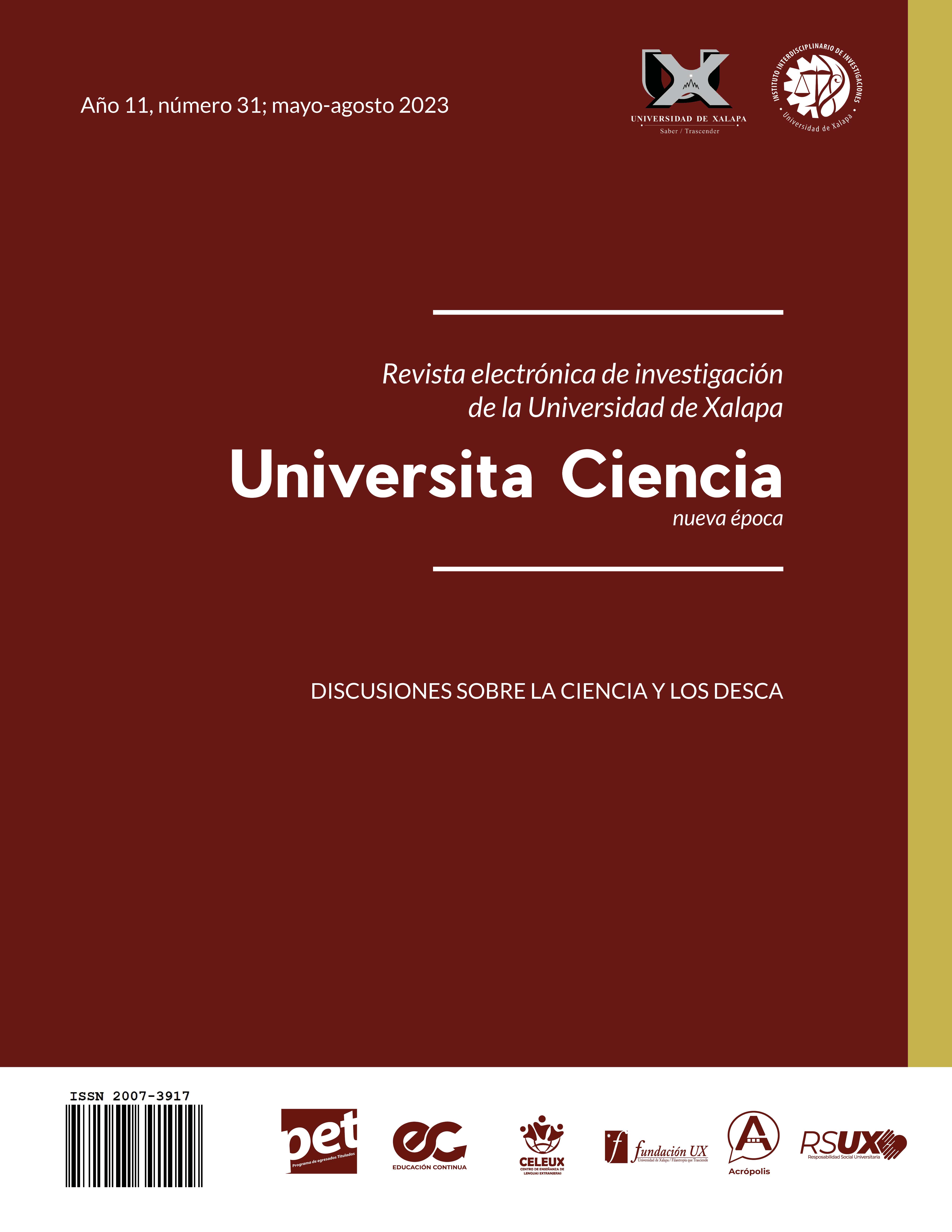Human Right to the Science Current Status in Mexico
DOI:
https://doi.org/10.5281/zenodo.8125327Keywords:
Human Rights, ESCER, Right to Science, Science and Technology, Third Generation RightsAbstract
The purpose of this article is to analyze the current situation of science as a human right in Mexico, as well as the achievements that have been made regarding its regulatory framework.
The interest in developing this approach arises from the fact that science and technology have been scarcely analyzed as part of economic, social, cultural and environmental rights (ESCER), despite
the fact that, currently, the dissemination of information and technological development have gained relevance as fundamental components of the information society.
Likewise, it is important not to disregard that science is a public good: although Mexico has been a pioneer country in terms of defending these rights in its constitution, the National Science and Technology System has not been
able to guarantee access this human right enshrined both in the Political Constitution and in several instruments of which Mexico is a party; which points to the need to analyze the efforts and advances of our State so that the right to
science is a reality for Mexicans.
Metrics
References
Beuchot, M. (2008). Filosofía y Derechos Humanos. México: Siglo XXI Editores.
Camhaji, A., Acosta, A., & Íñiguez, R. (2020). Forum 56. Derecho Humano a la Ciencia: su incorporación obligada en la LGBTI. Obtenido de Foro Consultivo Científico y Tecnológico AC: http://www.foroconsultivo.org.mx/FCCyT/revista-forum/forum-56-derecho-humano-la-ciencia-su-incorporaci%C3%B3n-obligada-en-la-lgcti#:~:text=El%20derecho%20a%20la%20ciencia,lugar%20de%20nacimiento%20u%20otro.
CNDH. (2019). Derechos Económicos, Sociales, Culturales y Ambientales (DESCA). México: Comisión Nacional de Derechos Humanos.
Conacyt. (2022). COMPARATIVO ENTRE LA LEY DE CIENCIA Y TECNOLOGÍA Y EL ANTEPROYECTO DE LEY GENERAL EN MATERIA DE HCTI. México: Gobierno de México.
Cuevas, M. (2019). Las tres generaciones de los Derechos Humanos. CODHEM, 93-102.
DOF. (08 de mayo de 2023). DECRETO por el que se expide la Ley General en Materia de Humanidades, Ciencias, Tecnologías e Innovación, y se reforman y adicionan diversas disposiciones de la Ley Federal de las Entidades Paraestatales y de la Ley de Planeación. Diario Oficial de la Federación.
Dreier, R. (2021). Derecho y Jusricia. Bogotá: Editorial Temis S.A:.
Elizalde, R. R., & Bonzo, C. (2018). Los derechos difusos en México. Una mirada desde el derecho comparado. Dike, 27-50.
Espinoza, R., & Gómez, K. (2023). El derecho humano a la ciencia: contenido, principios y garantías. Revista del posgrado en derecho de la UNAM , 21-83.
Gobierno de México. (2023). Qué es el Conacyt. Obtenido de Conacyt: https://conacyt.mx/conacyt/que-es-el-conacyt/#:~:text=El%20Consejo%20Nacional%20de%20Ciencia,tecnol%C3%B3gica%20de%20M%C3%A9xico%20y%20bajo
Mendoza, E., & al, e. (2019). Derecho Económico. México: IURE Editores.
ONU. (2016). Agenda 2030 y los Objetivos de Desarrollo Sostenible Una oportunidad para América Latina y el Caribe. Santiago: CEPAL.
Poder Legislativo del Estado de Jalisco. (4 de Agosto de 2021). Poder Legislativo del Estado de Jalisco. Bibilioteca Virtual. Obtenido de https://congresoweb.congresojal.gob.mx/BibliotecaVirtual/busquedasleyes/Listado.cfm#Leyes
Sánchez, V. (27 de junio de 2017). Los desafíos de la ciencia y tecnología mexicana. Obtenido de Cienciamx: http://www.cienciamx.com/index.php/sociedad/politica-cientifica/16361-desafios-ciencia-tecnologia-mexicana#:~:text=%2D%20El%20desarrollo%20cient%C3%ADfico%20y%20tecnol%C3%B3gico,los%20esquemas%20de%20jubilaci%C3%B3n%20y
UNESCO. (2020). El Derecho a la Ciencia. Obtenido de UNESCO: https://es.unesco.org/fieldoffice/montevideo/DerechoALaCiencia#:~:text=%E2%80%9CToda%20persona%20tiene%20derecho%E2%80%A6%20a,de%20los%20Derechos%20Humanos%2C%20Par%C3%ADs%2C
Published
How to Cite
Issue
Section
License

This work is licensed under a Creative Commons Attribution-NonCommercial-ShareAlike 4.0 International License.
This journal adheres to the Creative Commons license in the definition of its policy of open access and reuse of published material, in the following terms:
- Accessibility to articles and other publications in whole or in part under the concept of copying, distribution, public communication , interactive access (through the Internet or other means), explicitly maintaining the recognition of the author or authors and the journal itself (authorship acknowledgment).
- Warning that if the articles are remixed, modified or fragments used in other creations, the modified material cannot be distributed, nor is it allowed to reconstruct versions from the original published articles (derived works).
- The use of the contents of the published articles, in whole or in part, for profit (non-commercial recognition) is prohibited.
The author retains copyright, transfers or grants exclusive commercial rights to the publisher, and a non-commercial license is used.














